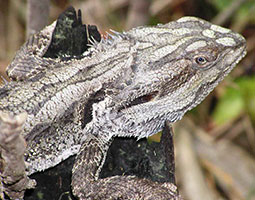Pogona barbata
Description

The Eastern Bearded Dragon (Pogona barbata) is a lizard that grows to approximately 55 cm in length and is usually grey in colour. Dragons are diurnal (active during the day) and semi-arboreal (spend most of their life on logs and branches) retreating to lower and darker places when too hot.
Eastern Bearded dragons are common in open forests like Toohey Forest, heathland, scrub and even farmland. Their main requirement are trees that they can utilise for escape from predators or sun baking. In farmland they will often use fence posts to sun bake.
The male adult dragons often have tooth damage, a result of combat with another male during the breeding season. In spring male dragons attract the attention of females with a series of frantic head bobs and arm waving. A month or so after mating, the female lays a clutch of 10-20 oval shaped white eggs with soft, flexible shells. These are laid in a shallow hole dug into the soil in an open sunny spot. The eggs hatch after two months of incubation.
Adaptations
- Rough grey skin provides excellent camouflage on logs
- They can regulate their body temperature by changing their skin colour (dark grey absorbs more heat than light grey)
- Their great climbing ability is useful to escape predators
- Flattening their bodies makes them look larger to scare predators
Feeding relationships
- What I eat: Leaves, fruits, berries and flowers make up 80 to 90% of my total diet. The remainder of diet is made up of different insects
- What eats me: Large goannas, snakes and birds of prey
Interesting facts
In south-eastern Australia the bearded dragon is often called a ‘Frilly”. The true frilled lizard (Chlamydosaurus kingii) occurs in more northern locations and has a very prominent frill.